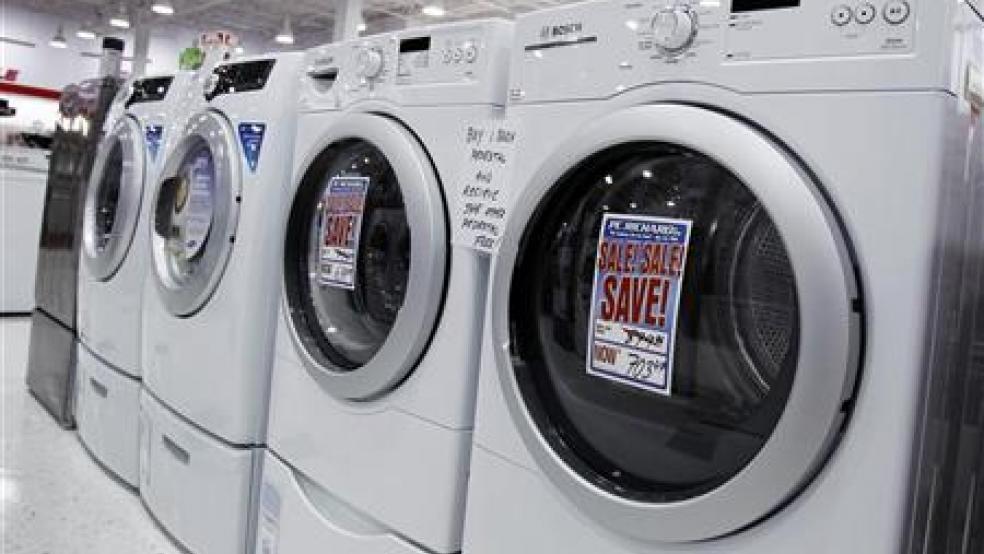WASHINGTON (Reuters) - Demand for long-lasting U.S. manufactured goods tumbled by the most in three years in March and businesses cut back on spending plans, suggesting the economy slowed as the first quarter drew to a close.
Durable goods orders dropped 4.2 percent, the largest decline since January 2009 when the economy was nose-diving, Commerce Department data showed on Wednesday. Economists had expected a drop of just 1.7 percent.
February orders were revised to show only a 1.9 percent increase instead of the previously reported 2.4 percent rise.
"This adds to the evidence that momentum in the economy sort of fell flat in March," said Ellen Zentner, a senior U.S. economist at Nomura Securities in New York.
Data on durable goods, items ranging from toasters to aircraft that are meant to last three years or more, is notoriously volatile, and investors on Wall Street shrugged off the report.
The data was the latest to show the factory sector losing a step in March and reinforced the Federal Reserve's view of moderate growth over the coming quarters.
Fed policymakers, in a statement at the end of their two-day meeting on Wednesday, reiterated they see modest growth, but also said they expect economic growth "to pick up gradually."
But even as the U.S. central bank bumped up its outlook for growth this year, it trimmed its growth outlook for both 2013 and 2014.
The Fed also repeated its pledge to keep interest rates on hold until at least late 2014, and Chairman Ben Bernanke said the Fed "would not hesitate" to do more to stimulate the economy if necessary.
Those comments along forecast-beating results from Apple helped drive U.S. stocks higher. The technology-laden Nasdaq Composite index notched its biggest one-day percentage gain for the year.
Prices for long-dated U.S. Treasury debt fell, while the dollar weakened marginally against a basket of currencies.
^^^^^^^^^^^^^^^^^^^^^^^^^^^^^^^^^^^^^^^^^^^^^^^^^^^^^^^^^
Graphic - U.S. durable goods
http://link.reuters.com/bad87s
^^^^^^^^^^^^^^^^^^^^^^^^^^^^^^^^^^^^^^^^^^^^^^^^^^^^^^^^^
MANUFACTURING LOSING SPARK
Wednesday's report on durable goods followed data last week that showed industrial production was flat in March for a second straight month, while some gauges of regional factory activity weakened in April.
Other recent signs of possible weakness in the U.S. economy include a sharp slowdown in jobs growth in March and an ebbing in consumer confidence this month.
But there was a silver lining in the durable goods report. The data suggested that growth in business capital spending rose again in the first quarter and will support economic growth.
Although non-defense capital goods orders excluding aircraft, a closely watched proxy for business spending plans, fell 0.8 percent in March, the figure for February was revised up to show a 2.8 percent gain, from the previously reported 1.7 percent increase.
In addition, shipments of non-defense, non-aircraft capital goods orders, which are part of the calculation of gross domestic product, rose 2.6 percent after increasing 1.4 percent in February.
The U.S. Commerce Department's first reading on GDP for the first quarter, to be released on Friday, is expected to show that the economy grew at a 2.5 percent annual rate, according to the median of a Reuters poll. Output expanded at a 3 percent pace in the fourth quarter.
The drop in orders for durable goods and an expected rise in inventories in the first quarter could set the economy up for a soft patch heading into the middle of the year.
"Unexpected weakness in core orders in March suggests less growth of equipment and software spending in the second quarter, and more first-quarter inventory investment suggests a larger decline in inventory investment in the second quarter," said Ben Herzon, an economist at Macroeconomic Advisers in St. Louis.
Orders for durable goods last month were dragged down by a 12.5 percent plunge in bookings for transportation equipment - the most since November 2010 - as aircraft orders tumbled. Boeing received only 53 orders for aircraft, according to the plane maker's website, down from 237 in February.
Orders for motor vehicles barely rose last month. Excluding transportation, orders fell 1.1 percent after a 1.9 percent rise in February.
(Editing by Leslie Adler)


